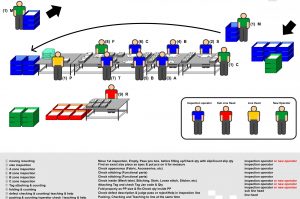
Some buyers don’t want random inspections. They don’t trust the manufacturer to produce consistently at the right quality level. So they need to check 100% of the goods.
A few months ago, I described inspections on a platform, where the shipment is inspected outside of the factory before being shipped out (if it is accepted for shipment). Some large importers of apparel resort to this solution. It is also very popular with Japanese buyers.
However, it is impossible in countries like Indonesia, where most factories are in free-trade zones (and are considered bonded warehouses). The manufacturers get the fabrics and the accessories free of import duties, and they must ship the goods out directly. They can’t take the products to another warehouse.
Then, how do demanding importers do, when platform inspections are not an option?
The line inspection process
I recently met with the founder of Saxa, an Indonesian quality control firm. He explained to me that they set a team of 10 ladies at the end of each production line.
I got the below explanation from Saxa’s website (click on the image to enlarge).
The process looks like this:
- The QC team checks the garments and sorts out the defectives
- The factory packs them
- A QC team member checks the quantity and breakdown inside the cartons, which are then sealed.
There is one problem with this setup: the manufacturer doesn’t care about the 15% of pieces that need some rework. They are not aware of what it costs them, therefore they don’t make efforts to improve their reliability.
How to align the buyer’s and the manufacturer’s interests?
Saxa recently started to adopt a different approach with the help of some clients:
- They start with piece-by-piece inspection (paid by the manufacturer)
- They see what defects come up most often
- They give advice to the manufacturer to decrease the most frequent defects
- If the proportion of defectives goes below a certain target, they switch to random inspections (paid by the importer)
- If the proportion of defectives goes back up, they switch back to piece-by-piece inspection (paid by the manufacturer)
I love this deal. In the mid-to-long run, it decreases the costs for the importer by forcing the factory to address the real issues.
What do you think? Any similar example?
No comments:
Post a Comment